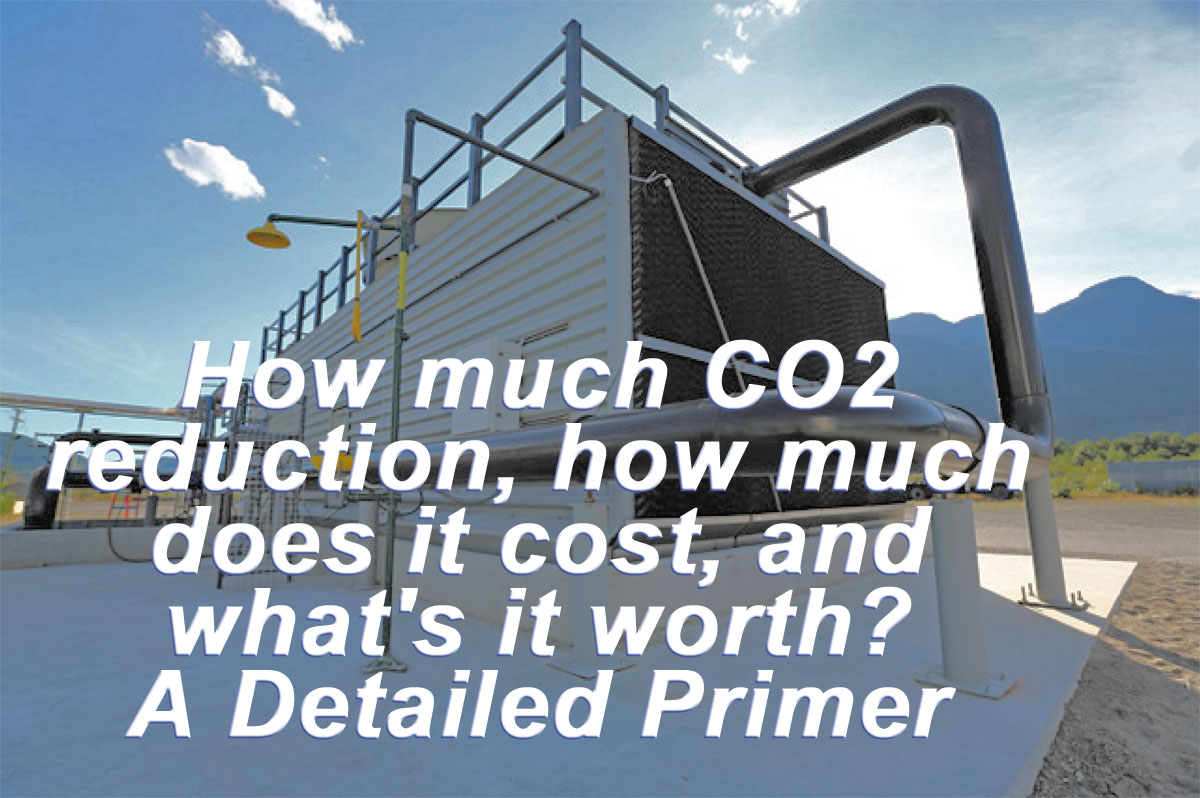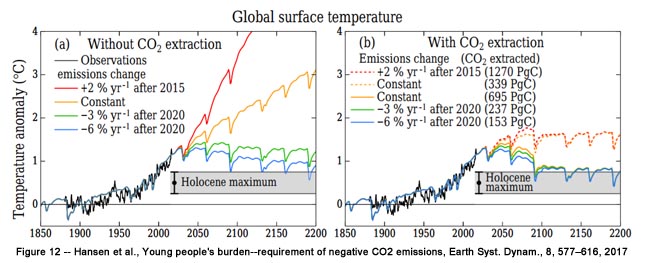
Joule, Corrected proof. doi:10.1016/j.joule.2018.05.006
How much CO2 reduction, how much does it cost, and what’s it worth?
A Detailed Primer
We have been moving towards the answers to these questions forever it seems, so here goes:
Immediately below is my summary. Further down are thoughts on how I arrived at these numbers. These costs assume that we can do what it takes to return CO2 to somewhere near 300 ppm far faster than current climate culture suggest for climate reform (10 to 20 years.) It also assumes that 300×2050 (300 ppm CO2 by 2050) restabilizes abrupt changes that have already begun and that geoengineering strategies are not deployed (like refreezing the Arctic or solar radiation management.) At the very bottom is a rationalization of how we can afford costs–if benefits do not outweigh costs creating a net profit scenario, and also very important–how we deal with 36 percent of current warming caused by non CO2 greenhouse gases:
How much CO2 reduction, how much does it cost, and what’s it worth?
- Total atmospheric CO2-EQ reduction in Gigatons (Gt) 1,000
- Net cost (billions US Dollars, current day) Cost for Removal Removal Plus Storage at $10/ton CO2
*** At $200/ton CO2 removal $52 trillion $55 trillion
*** At $100/ton CO2 removal $26 trillion $28 trillion
*** At $20/ton CO2 removal $5.2 trillion $8 trillion
- Costs of abrupt sea level rise $200 to $800 trillion over 30 years, current value
- Net savings (billions US Dollars over 30 years, current value) Removal Plus Storage at $10/ton CO2
*** At $200/ton CO2 removal $145 to $745 trillion
*** At $100/ton CO2 removal $174 to $774 trillion
*** At $20/ton CO2 removal $192 to $792 trillion
Time and rate of CO2 removal (negative emissions) are important. Can we feasibly decarbonize and build a CO2 removal infrastructure in 10 years or will it take 50 years? Net costs of emissions reductions are important. Will there be net costs or net profits/benefits from decarbonizing?
~ ~ ~
Below are some thoughts on costs based on Hansen 2008:
Hansen, Target Atmosphere 350, 2008, paragraph 1, page 227
These numbers are simplified and do not consider things like off gassing of CO2 from the oceans when atmospheric CO2 is reduced.
- At $200 ton CO2 removal, 50 ppm atmospheric CO2 drawdown (400 ppm CO2 to 350 ppm CO2) costs $20 trillion, or 100 ppm CO2 (776 Gt CO2) to get to 300 ppm is $40 trillion.
- 1 ppm CO2 = 2.12 Gt carbon or 7.76 Gt CO2, so 100 ppm CO2 is 776 Gt CO2.
- Per Gt CO2 at $200/ton is $52 billion per Gt CO2.
- To consider offgassing from the oceans and other sources, round up to 1,000 Gt CO2, or $52 trillion at $200/ton.
- At costs for Carbon Engineering’s new paper (from Keith et al, June 2018) at $94/ton, this is about $26 trillion.
- Considering Carbon Engineer’s price will drop significantly, and that other technologies (Global Thermostat, Lackner’s moisture swing) could be more cost efficient, and energy costs are plummeting–which further reduces costs because it removes the CO2 penalty for hydrocarbon energy, and cost reductions for scaling to the Gt level (100,000 times more than Carbon Engineering’s 1 million tons/year), a target of the low tens of $$$ per ton is likely, with single digits per ton feasible.
- At $20 per ton CO2 removal, the cost is $5.2 trillion.
- These costs are in addition to emissions reductions costs — if there are actually costs involved with emissions reductions/efficiency measures. Many argue that there are/will be not costs because the net, when costs and benefits are valued, is positive — that is, decarbonization generates net profits, not net costs. Jacobson 2013 at Stanford (my review article,) and his Solutions Project argue that benefits far outweigh costs.
- Also not in the above numbers is disposal. Blue Planet says that using their synthetic aggregate technology (in non peer review,) the cost is a few dollars per ton CO2. Most of the other work I have seen rates disposal in the single digit $/per ton so conservatively, add another $10/ton for disposal or $2.6 trillion. This considers of course that disposal does not generate profit. The average 2017 cost of sand and gravel (Blue Planet’s aggregates) is over $8/ton. We use over 50 Gt aggregates across the planet annually, or about 30 Gt CO2.
Net Savings:
This is a tough one with very few capturing the real costs of climate change. My analogy is stark, but because most things with climate change have turned out to be substantially more stark than previously projected, my engineering brain says go with stark. I use my engineering brain in this thought exercise because I have been trained for over 30 years to base outcomes on risk. Because of the outsized risk of abrupt changes radically altering life as we know it, I choose abrupt changes because life as we know it is by far the single most important thing that ever was.
- Costs for abrupt change will be dramatically more than for consensus statements upon which policy is based (current climate culture) because abrupt changes are 10 to 100 times (or more) more extreme than our current climate culture suggests climate change impacts will be.
- Picking an abrupt change with outsized impacts: I select abrupt sea level rise (there are many — methane outgassing, Gulf Stream shutdown, etc.) Margaret Davidson (now deceased) at NOAA said in 2016 that data already collected but yet to be published shows 10 feet of sea level rise by mid-century. Prehistoric evidence shows 10 to 20 feet of sea level rise repeatedly in the past, with ice volume on Earth similar to today.
- The IPCC says that the adaptation limit to sea level rise is 3 feet per century, and the IPCC has understated almost everything so far.
- Ice sheet collapse begins with 10 feet of sea level rise by mid-century (according to Davidson and the prehistoric record), and proceeds for centuries on end at 10 to 20 feet per century creating an unrecoverable scenario, in time frames that matter.
- A large portion of mankind’s wealth is located near sea level, with a disproportionately large amount of global infrastructure near sea level.
- Ice sheet collapse would compromise most of this outsized proportion of infrastructure.
- Global per capita net worth is about $250 trillion. Global infrastructure value is another +/- $250 trillion. So not taking into consideration the cost of reconstruction of global assets, mankind’s civilization is worth $500 trillion.
- An unrecoverable economic collapse because of abrupt sea level rise would jeopardize a large portion of world assets and wealth, say $200 trillion.
- We can also look at it from a GDP standpoint: Jeopardizing 40 percent of global GDP for 30 years, at $70 trillion annual global GDP, is $840 trillion.
Note on Time Frames and Rate of CO2 Removal:
Time frames and the rate of negative emissions matter a lot. If we were to remove 776 Gt tomorrow, what comes back out of the oceans and etc. over the next 20 or 50 years would easily be removed through the infrastructure we put in place to remove 776 Gt. A lot more removal (negative emissions) is required with lower emissions reductions and a lower annual rate or removal. Hansen’s Young People’s Burden 2017 (my article on the paper here) illustrates. Hansen’s Target is 350 ppm CO2 by 2100. There is no modeling yet for 300 ppm CO2 by 2050, but Hansen illustrates the concept of delay and amount of negative emissions very well. His numbers do include offgasing with the best numbers that we know of today.

Looking at the graph on the right “With CO2 Extraction” — This is atmospheric CO2 removal plus emissions reductions to. (Green line at 3% annual emissions reductions approximates Paris.)
1) Orange dots — business as usual with 2% annual emissions growth and 4,660 Gt CO2 removal by 2100 (58 Gt average annually.) The temperature rises nearly another degree and stays there beyond 2200.
2) Yellow dots — constant emission, no change from today. 1,243 Gt CO2 removal by 2100 (16 Gt CO2 average annually.) The temperature rises nearly another degree and stays there beyond 2200.
3) Yellow line — constant emissions, no change from today. 2,550 Gt CO2 removal by 2100 (32 Gt average annually). The temperature falls back to where it is today by 2100.
4) Green line — 3% annual emissions reductions. 870 Gt CO2 removal by 2100 (11 Gt average Annually.) The temperature falls back to where it is today by 2100.
5) Blue line — 6% annual emissions reductions. 560 Gt CO2 removal by 2100 (7 Gt average annually.) The temperature falls back to where it is today by 2100.
How Can We Afford All This?
We spent $11 trillion over five years in WWII, mostly on heavy industrialization and manufacturing. This was 73 percent of global GDP. Seventy-three percent of five years of global GDP today at $78 trillion per year is $285 trillion. We need to remove +/- 100 ppm CO2 to return our climate to a healthy state, which is $52 trillion for 1,000 Gt CO2 at Hansen’s $200/ton or $20 trillion per 50 ppm CO2. At $100 per ton for 1,000 Gt CO2 the total bill is $26 trillion, or about 10 percent of what we spent during World War II. At $20/ton it’s 2 percent of what we spent on WWII. Either way, it’s a small fraction of what we are capable of as shown by history.
Where is the $$$ going to come from?
We spend $3.5 trillion in the U.S. every year on health care. We spend a half trillion every year across the planet on advertising. Sure we can do this. All we need to do is become motivated.
What About Non CO2 Greenhouse Gases?
Thirty-six percent of warming we are experiencing today is from non CO2 greenhouse gases. There are very few identified mitigations for non CO2 greenhouse gases save one. Photocatalytic Solar Energy Generating Chimney’s can deal with non CO2 GHGs — most all of them. The facility in the link below is in Xi’an China, population 13 million. It uses a titanium catalyst and generates 200 Mw electricity too, while deactivating non CO2 greenhouse gases. Some of them, like methane, it converts to CO2, which has only a few percent of the warming potential of CO2 in the 20-year time frame which is vitally important right now.
This link needs to be translated — see instructions below:
https://view.inews.qq.com/a/20180118A0H1AP00
Right click on the page and click on “translate…” The photocatalyst automatically promotes degradation of non greenhouse gas pollutants as well as other air pollutants. No disposal required. The chimney operates for free based on solar absorption in the day and solar absorption stored heat at night.
Here’s one of only a few papers describing this already installed technology — de Richter 2017.
